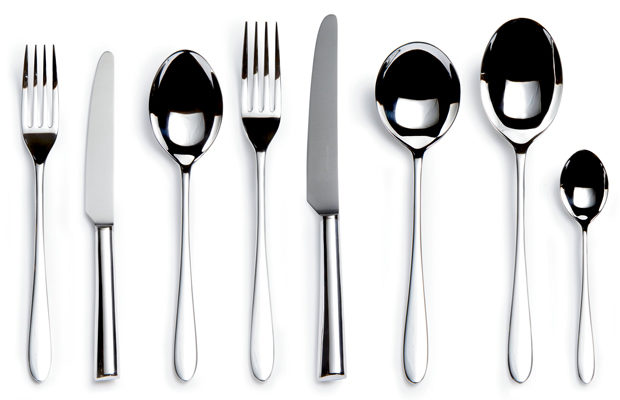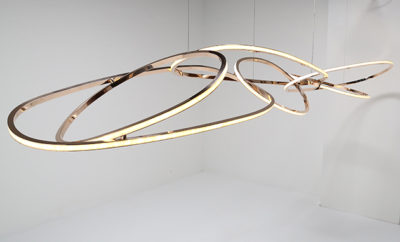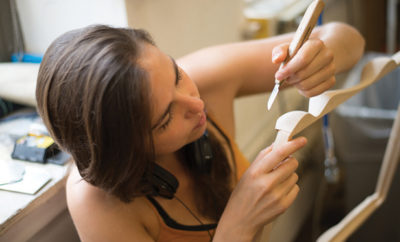
Design
Sharpest Knife in the Box

Pieces from the “Pride” collection, one of Mellor’s earliest tableware designs.
Sharpest knife in the box:
He was known as the “Cutlery King,” but David Mellor also helped reshape Britain’s postwar urban landscape
WE USE THEM EVERY DAY. They’re in our kitchen drawers, or on the dining table. Knives, forks, spoons—and unless they’re heirloom silver, we don’t give much thought to their history, design, or manufacture. But one man devoted his life to the subject. In the catalogue accompanying the 1998 exhibition David Mellor: Master Metalworker at the Mappin Art Gallery in Sheffield, England, historian Fiona MacCarthy (who happened to be Mellor’s wife) wrote: “He has been motivated by an extreme perfectionism … the angle of the blade, the roundness of the spoon, the precise sharpness of the prongs … all so carefully worked out.”
If, as it’s said, birthplace is destiny, Mellor is proof. The designer was born in 1930 in Sheffield, the center of English cutlery production since the seventeenth century, and throughout his life the bluff, self-effacing Yorkshireman rarely strayed from his roots. Mellor’s father was a toolmaker, and it seems almost inevitable that his son would be drawn to metalwork. In a junior level class at the Sheffield Art School, he made his first piece at the age of twelve: a dessert dish of gilding metal—a type of brass—with a twist rim and handles
Following two years of service in an army tank corps, Mellor enrolled in 1950 at London’s Royal College of Art, where the postwar mission was to revitalize the country’s manufacturing by promoting new design. One of Mellor’s earliest pieces was a kettle in the arts and crafts style but with a decidedly elongated spout, a signal of his move toward a contemporary sensibility. While at the RCA he designed the prototype for a line of silverplate cutlery called “Pride”—a design that was simple, elegant, and restrained. After graduation in 1954 Mellor returned to Sheffield, where he set up a silversmithing workshop and became a design consultant to Walker and Hall, a venerable silverplating company. They put his “Pride” cutlery—which in 1957 won one of England’s inaugural Design Centre Awards—into production and followed up with a silverplate tea service of the same name. In 1962 the company opened a new factory devoted to the production of stainless steel cutlery. The year before, Mellor had developed the “Symbol” collection—the first high quality stainless steel cutlery produced in quantity in Britain.
To put Mellor’s career in tableware design in perspective, for centuries cutlery forms had barely changed. The costly materials involved meant that most people purchased only one set during their lifetime, giving manufacturers little incentive to expand beyond existing styles. Mellor’s “Symbol” line, employing less expensive stainless steel, opened the door for others to devise new designs and manufacturing methods. This was all of a piece with Mellor’s career. He had two guiding principles: first, that good design would enhance the quality of life; and second, that tradition should not be sacrosanct.
He applied both principles to industrial design. For the Midlands engineering firm Abacus, he designed street lights inspired by those he had seen in Rome’s Borghese Gardens, as well as bus shelters—an estimated 140,000 of these minimalist units, designed to discourage vandalism have been installed since 1959—traffic lights (still in use today), and a new version of the British letter box, which had changed little since 1879.
In 1960 Mellor moved to the Sheffield suburb of Broomhall, where he built a glass and timber house containing a workshop, design studio, and living quarters. The architecture was inspired by the home of Charles and Ray Eames in Pacific Palisades, California. Around this time he was commissioned to design new tableware in sterling silver for use in British embassies, and soon after a line of stainless steel cutlery, which he called “Thrift,” for government institutions.
Four-square north Englander that he was, Mellor was not averse to catering to the gentry. In 1969 he opened a shop on London’s chic Sloane Square—Terence Conran’s first Habitat store on nearby Fulham Road had opened five years earlier—stocking a selection of tableware and kitchenware, most of his own design. As one anecdote goes, Mellor helped Jacqueline Kennedy Onassis purchase a wedding gift, all the while having no idea who she was.
As the years went on Mellor grew frustrated with the fact that larger manufacturers were producing his designs, depriving him of control of the final product. In 1973 he began producing products at Broom Hall, a fifteenth-century building near Sheffield that he turned into a combination design studio, workshop, factory, and home. He hired novice cutlers and employed a rotating system that allowed workers to learn all aspects of cutlery design and manufacture, giving them involvement in all aspects of a project. By the late 1980s Mellor’s business had outgrown Broom Hall, and he commissioned a new plant in the village of Hathersage, about twelve miles from Sheffield. Built upon the circular foundation of a disused gasworks, the new factory is a design icon called the Round Building, and is still the center of the company Mellor founded.
The David Mellor Design Museum opened in 2006 opposite the factory, three years before Mellor’s death in 2009. The year he died, an admiring Mellor monograph was published, which included a foreword by his old Sloane Square neighbor Terence Conran, who wrote: “I nominate David Mellor as Britain’s most serious, modest and greatest postwar product designer.” Well-deserved praise from Caesar.












